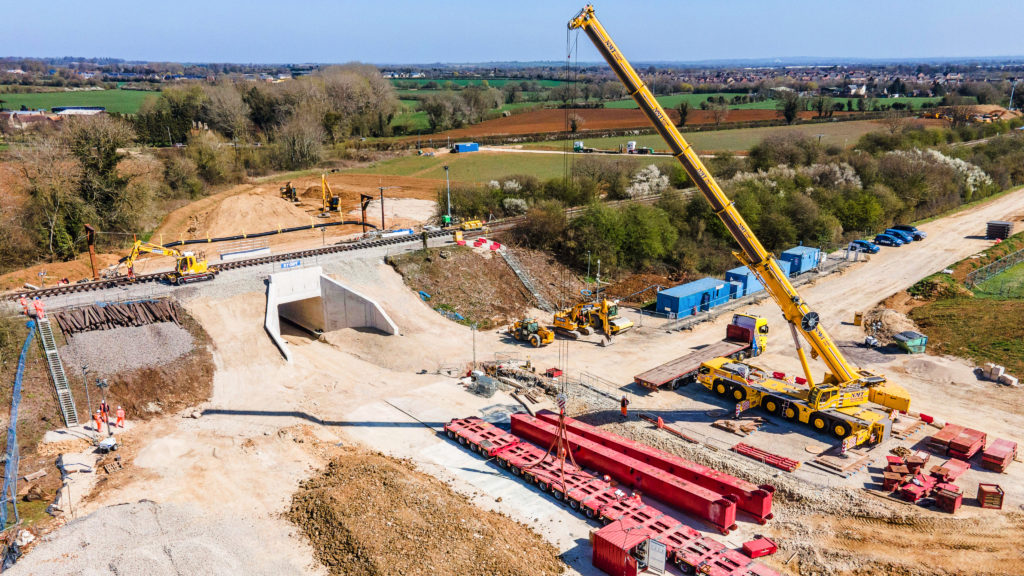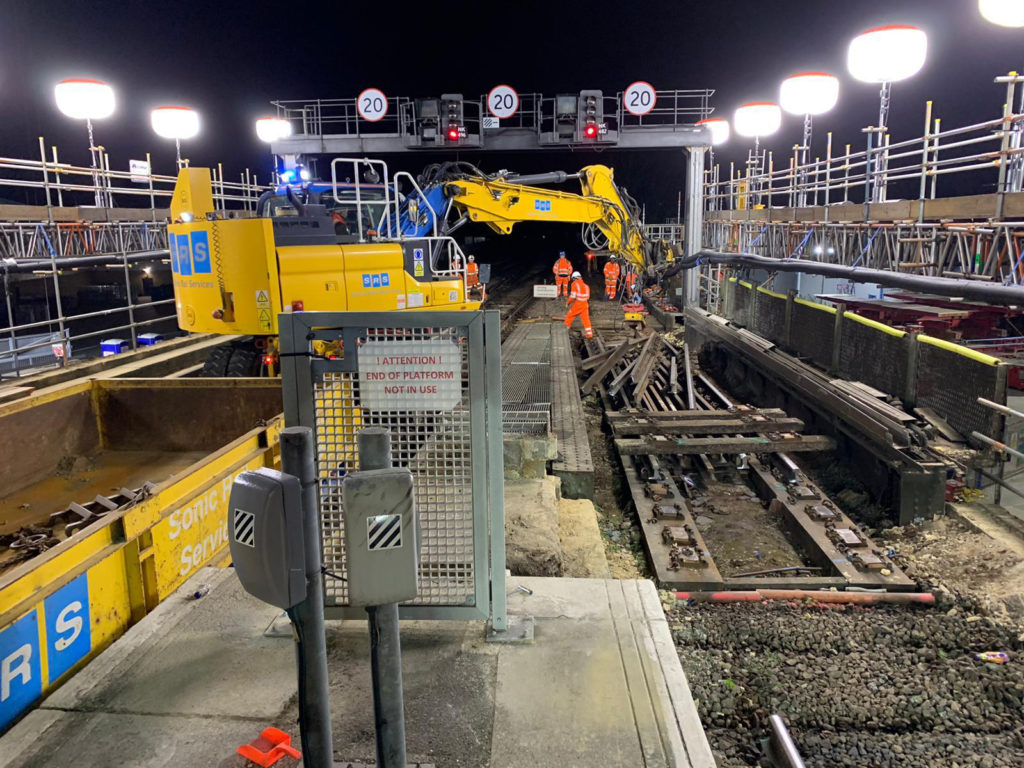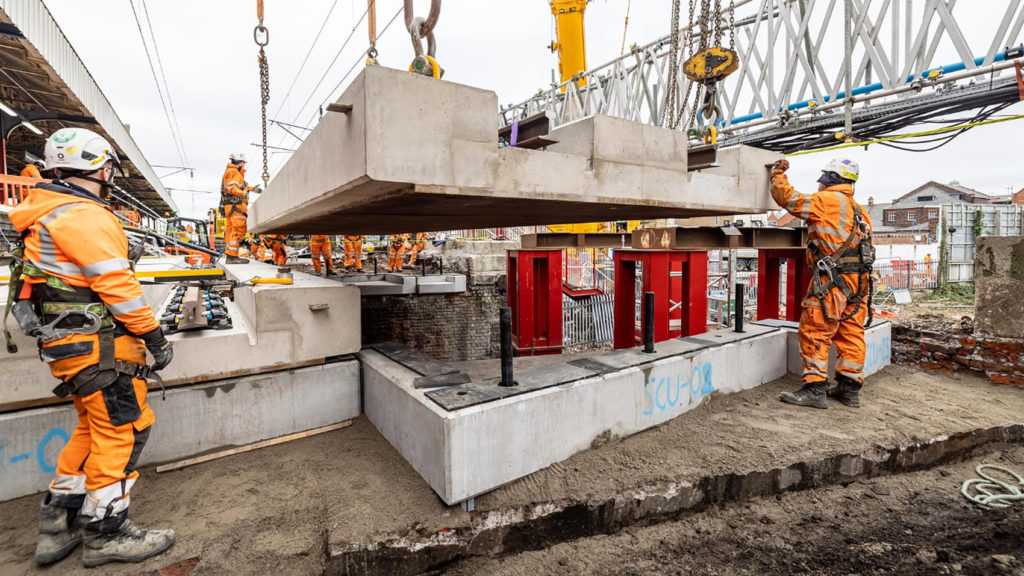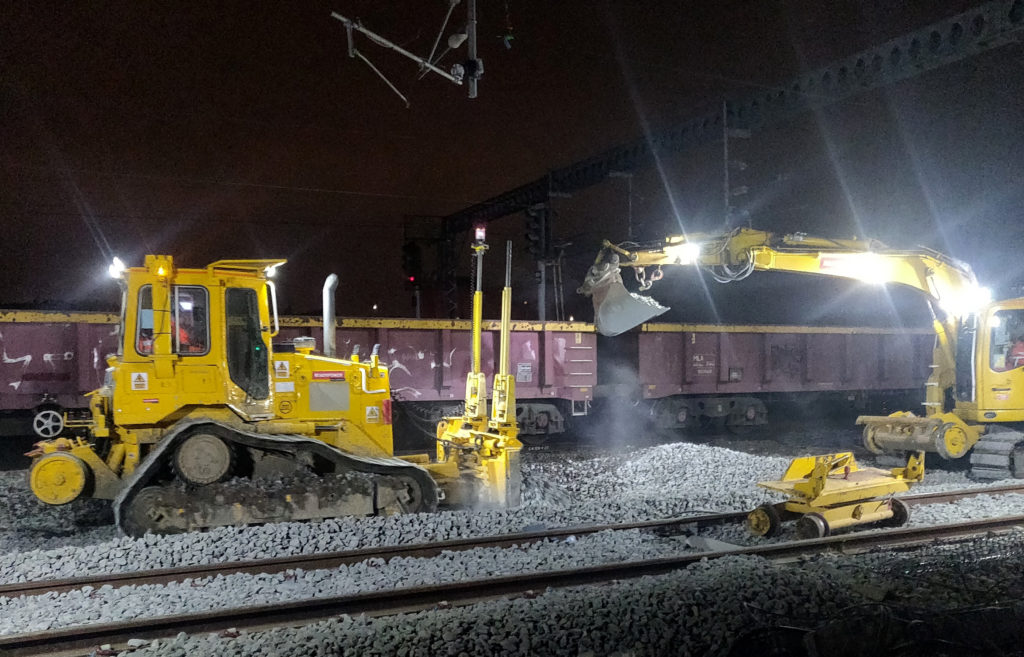For most of us, bank holidays are a time to gather in the pursuit of enjoyment. But all that has been curtailed this year and last by…you know what. When we’ve most needed things to smile at, they’ve been hard to come by.
It was business as usual though – more or less – for the railway family over Easter as the supply chain progressed £116M worth of engineering work at 4,000 worksites in 1,200 possessions, completing major enhancements, core renewals and routine maintenance. And over the May bank holiday weekend, there was activity at a further 3,000 sites, with a value of around £80M. At 50 of these locations, the projects were identified as ‘red’ through the Delivering Work Within Possessions standard, bringing a greater risk of overrun and significant impacts on services.
The ongoing East Coast Upgrade was pushed forward at King’s Cross with the replacement of track, signalling and overhead line equipment through the one-and-a-half mile section approaching the station. The signal box was taken out of service on 23 April during a four-day closure of the station; control has now been transferred to York ROC. Gasworks East Tunnel reopened after 40+ years of redundancy on 26 April.
Enabling works for HS2 were undertaken at Euston whilst large-scale enhancements continued in Leeds. But, away from these bright spotlights, a collection of smaller schemes came to fruition over the two bank holidays, bringing benefits both operationally and for the railway’s customers. Here are the edited highlights.

New bridges
The A4095 strategic link road is an important element of the North West Bicester eco-town master plan. To build it, a new underbridge was needed to support the Marylebone-Aynho Junction line, together with a nearby underpass. Both structures were constructed over Easter, together with 400m of track renewals.
During the 100-hour possession, 21,000 tonnes of embankment were removed, allowing the prefabricated structures – with a combined weight of 2,100 tonnes – to be moved into position on transporters.
In Dartford, three metal bridge decks over Hythe Street were replaced with ‘U’ decks and holding-down restraints to mitigate against bridge strikes. Repairs to the brickwork and abutment drainage were also undertaken. The structures were life-expired and contained hidden critical elements which could not easily be inspected.
A crane and transporter were used to replace a bridge at Warrington Bank Quay Station, lifting out the old deck sections and installing two concrete-encased steel units. Another bridge, which had previously been infilled with foam concrete, was also taken out. The removal of longitudinal timbers from the workbank will reduce future maintenance requirements.
Over the May Bank Holiday, the EWR (East West Rail) Alliance completed the installation of 103 deck beams over the West Coast Main Line and re-registered overhead line equipment on all four main lines through Bletchley. This work continued the Alliance’s programme to complete a flyover, allowing construction of the new railway towards Bicester to get underway this winter.
Track replacement
Significant plain line and S&C projects were undertaken, including at the site of the Brent Cross West Station which will bring 7,500 new homes within 15 minutes of central London. As well as slewing the Slow lines and renewing three sets of points, signals were relocated and the OLE realigned.
At Stratford, 687 yards of plain line was renewed on the Up Main through Platform 9 using seven engineering trains. The new track was welded and stressed, enabling the site to be handed back at 60mph rather than the booked 50mph TSR.
Track quality data had deemed a site at Newark Castle Station in Nottinghamshire to be very poor, with numerous track defects recorded historically. Here, the renewal of 40 yards of track through a level crossing has removed the risk of a speed restriction being imposed.

The upgrading of Wilton Junction between Salisbury and Wilton included the renewal of all the S&C and associated plain line. The primary driver was to renew the life-expired ballast and track components, improving performance and geometry.
Meanwhile at Nunnery Junction, Sheffield, a two-stage project was completed involving the relaying of the Up/Down Main and Worksop lines, four point renewals, two points being plain-lined and reballasting across the entire junction. The use of a welding supervisor allowed all 80 welds to be completed, with the railway opening on time at 70mph.

Operational improvements
The Stratford rewire project is replacing the existing overhead line equipment with a modern auto-tensioned design between Stratford and Maryland stations. Currently, the OLE is fixed termination and cannot maintain full tension during periods of hot weather, requiring speed restrictions to prevent dewirements. Considerable progress was made over Easter.
Meanwhile, works were undertaken to increase the resilience of overhead line equipment within Beechwood Tunnel, west of Coventry, following severe disruption caused by a failure during summer 2019. Included was the replacement of the contact wire and installation of an equalising plate.
The Feltham & Wokingham Resignalling Programme involves the renewal of all signalling assets and recontrolling the system to the Basingstoke Rail Operating Centre (BROC). Phase 1 covers the area from Richmond to Whitton and Norbiton to Twickenham, extending the ElectroLogIXS signalling system and delivering enhancements with the installation of two new crossovers at Twickenham and St Margarets.
Over the five-day Easter commissioning period, the project completed a number of key tasks including the renewal of the road lights and barriers at Strawberry Hill level crossing, whilst 45 life-expired signals were removed, six new signals erected, telecoms alterations completed for signal post telephones, system testing and recontrol of the Shepperton branch to BROC.

In May, engineers finished an interim stage on the replacement of Scotland’s highest-risk Automatic Half Barrier (AHB) level crossing at Cornton with manually-controlled barriers monitored by obstacle detection. The AHB crossing was decommissioned from the signalling interlocking and work got underway on the installation of equipment for the new system.
Overall performance
There’s an understandable tendency to focus our attention on the big high-gloss schemes with budgets measured in billions, but strategic benefits are delivered every night of the week through the efforts of a workforce that rarely gets the credit it deserves. Key commissioning milestones are often concentrated around bank holidays and yet, despite the heightened risks, early May saw a successful possession hand-back rate of 98.9%, whilst Easter hit 99.6%.
There was a major injury near Wickford, Essex, when a MEWP basket was struck by an RRV attachment, causing an operative in the basket to suffer a broken leg. Rail Engineer extends its best wishes to the casualty and hopes for a speedy recovery. But the fact that such incidents are worthy of reporting is a reflection of how thankfully rare they are.
For all the stick the railway gets, it does so much right so much of the time.


